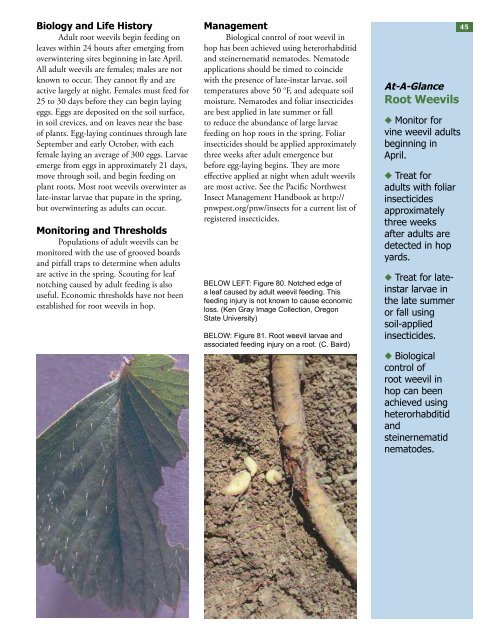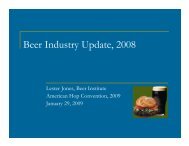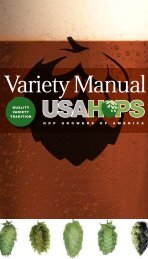Biology and Life HistoryAdult root weevils beg<strong>in</strong> feed<strong>in</strong>g onleaves with<strong>in</strong> 24 hours after emerg<strong>in</strong>g fromoverw<strong>in</strong>ter<strong>in</strong>g sites beg<strong>in</strong>n<strong>in</strong>g <strong>in</strong> late April.All adult weevils are females; males are notknown to occur. They cannot fly and areactive largely at night. Females must feed <strong>for</strong>25 to 30 days be<strong>for</strong>e they can beg<strong>in</strong> lay<strong>in</strong>geggs. Eggs are deposited on the soil surface,<strong>in</strong> soil crevices, and on leaves near the baseof plants. Egg-lay<strong>in</strong>g cont<strong>in</strong>ues through lateSeptember and early October, with eachfemale lay<strong>in</strong>g an average of 300 eggs. Larvaeemerge from eggs <strong>in</strong> approximately 21 days,move through soil, and beg<strong>in</strong> feed<strong>in</strong>g onplant roots. Most root weevils overw<strong>in</strong>ter aslate-<strong>in</strong>star larvae that pupate <strong>in</strong> the spr<strong>in</strong>g,but overw<strong>in</strong>ter<strong>in</strong>g as adults can occur.Monitor<strong>in</strong>g and ThresholdsPopulations of adult weevils can bemonitored with the use of grooved boardsand pitfall traps to determ<strong>in</strong>e when adultsare active <strong>in</strong> the spr<strong>in</strong>g. Scout<strong>in</strong>g <strong>for</strong> leafnotch<strong>in</strong>g caused by adult feed<strong>in</strong>g is alsouseful. Economic thresholds have not beenestablished <strong>for</strong> root weevils <strong>in</strong> hop.<strong>Management</strong>Biological control of root weevil <strong>in</strong>hop has been achieved us<strong>in</strong>g heterorhabditidand ste<strong>in</strong>ernematid nematodes. Nematodeapplications should be timed to co<strong>in</strong>cidewith the presence of late-<strong>in</strong>star larvae, soiltemperatures above 50 °F, and adequate soilmoisture. Nematodes and foliar <strong>in</strong>secticidesare best applied <strong>in</strong> late summer or fallto reduce the abundance of large larvaefeed<strong>in</strong>g on hop roots <strong>in</strong> the spr<strong>in</strong>g. Foliar<strong>in</strong>secticides should be applied approximatelythree weeks after adult emergence butbe<strong>for</strong>e egg-lay<strong>in</strong>g beg<strong>in</strong>s. They are moreeffective applied at night when adult weevilsare most active. See the Pacific NorthwestInsect <strong>Management</strong> Handbook at http://pnwpest.org/pnw/<strong>in</strong>sects <strong>for</strong> a current list ofregistered <strong>in</strong>secticides.BELOW LEFT: Figure 80. Notched edge ofa leaf caused by adult weevil feed<strong>in</strong>g. Thisfeed<strong>in</strong>g <strong>in</strong>jury is not known to cause economicloss. (Ken Gray Image Collection, OregonState University)BELOW: Figure 81. Root weevil larvae andassociated feed<strong>in</strong>g <strong>in</strong>jury on a root. (C. Baird)At-A-GlanceRoot Weevils◆◆Monitor <strong>for</strong>v<strong>in</strong>e weevil adultsbeg<strong>in</strong>n<strong>in</strong>g <strong>in</strong>April.◆◆Treat <strong>for</strong>adults with foliar<strong>in</strong>secticidesapproximatelythree weeksafter adults aredetected <strong>in</strong> hopyards.◆◆Treat <strong>for</strong> late<strong>in</strong>starlarvae <strong>in</strong>the late summeror fall us<strong>in</strong>gsoil-applied<strong>in</strong>secticides.◆◆Biologicalcontrol ofroot weevil <strong>in</strong>hop can beenachieved us<strong>in</strong>gheterorhabditidandste<strong>in</strong>ernematidnematodes.17 45
46 Twospotted Spider MiteJim D. BarbourFigure 82. Adult female spidermite with prom<strong>in</strong>ent black spotson each side of the abdomen.Adults are approximately 1/50<strong>in</strong>ch long. (D. G. James)Figure 83. Adult male spidermite. Males are approximately3/4 the size of females andhave a more po<strong>in</strong>ted abdomen.(D. H. Gent)<strong>Pest</strong> Descriptionand Crop DamageTwospotted spider mites (Tetranychusurticae) are closely related to spiders andticks and get their name from their spiderlikeability to sp<strong>in</strong> webs. Adult females aresmall, oval, yellow to yellow-green animals,approximately 1/50 <strong>in</strong>ch long, with a largeblack spot on each side of the abdomen(Fig. 82). Newly hatched spider mites(larvae) have three pairs of legs, whereas allother life stages (nymphs, adults) have four.Overw<strong>in</strong>ter<strong>in</strong>g females turn orange-red <strong>in</strong>the fall and lose the paired black spots. Asthey beg<strong>in</strong> feed<strong>in</strong>g <strong>in</strong> the spr<strong>in</strong>g, femalesturn green and rega<strong>in</strong> the spots. Adult malesare approximately 3/4 the size of femalesand have a more po<strong>in</strong>ted abdomen (Fig.83). Spider mite eggs are clear to pearlywhitespheres approximately 1/200 <strong>in</strong>ch <strong>in</strong>diameter (Fig. 84).Spider mites damage hop plants byfeed<strong>in</strong>g on leaves and cones, suck<strong>in</strong>g plantjuices from the cells. Leaf feed<strong>in</strong>g causesbronz<strong>in</strong>g of leaves and reduces plant vigor(Figs. 85 and 86). Severe <strong>in</strong>festation cancause defoliation and is accompanied byheavy production of webb<strong>in</strong>g (Fig. 87).Most economic damage is caused by spidermites feed<strong>in</strong>g on cones, which results <strong>in</strong>dry, brittle, discolored (red) cones (Figs.88 and 89) that tend to shatter, reduc<strong>in</strong>gboth quality and quantity of yield. Spidermites <strong>in</strong> hop cones are also consideredcontam<strong>in</strong>ants that lower cone quality. When<strong>in</strong>festations are severe, brewer rejection ortotal crop loss can occur.Biology and Life HistoryTwospotted spider mites have a widehost range, feed<strong>in</strong>g and reproduc<strong>in</strong>g on morethan 180 plant species, and are importantpests of many field, <strong>for</strong>age, ornamental,and horticultural crops. They overw<strong>in</strong>teras dormant or diapaus<strong>in</strong>g females <strong>in</strong> hopcrowns, cracks and crevices <strong>in</strong> poles, andother protected areas <strong>in</strong> fields and adjacentareas. Males do not overw<strong>in</strong>ter. Femalesemerge from overw<strong>in</strong>ter<strong>in</strong>g sites <strong>in</strong> earlyspr<strong>in</strong>g and immediately beg<strong>in</strong> feed<strong>in</strong>g onyoung shoots beneath bracts. Egg-lay<strong>in</strong>g canbeg<strong>in</strong> as early as two days after emergence.Eggs hatch <strong>in</strong> two to five days with femalesproduced from fertilized eggs and males fromunfertilized eggs. The sex of immature stages,however, cannot be accurately determ<strong>in</strong>ed.The larvae develop through two additionalmolts, the second <strong>in</strong>star (protonymph)and the third <strong>in</strong>star (deutonymph), be<strong>for</strong>ebecom<strong>in</strong>g adult mites. Developmentfrom egg to adult takes one to three weeksdepend<strong>in</strong>g on temperature. As many as fiveto eight overlapp<strong>in</strong>g mite generations perseason may occur on hop. Except whenpopulations are high, eggs and motile stagesare usually found on the undersides of leaves.Orange, diapaus<strong>in</strong>g females appear <strong>in</strong> lateAugust and September <strong>in</strong> response to shorterdays and cool<strong>in</strong>g temperatures, at whichtime mites beg<strong>in</strong> mov<strong>in</strong>g down plants tooverw<strong>in</strong>ter<strong>in</strong>g sites.Figure 84. Spider mite adult,nymphs, and eggs. The eggsare clear to pearly-whitespheres approximately 1/200<strong>in</strong>ches <strong>in</strong> diameter.(S. Broughton, Department ofAgriculture & Food WesternAustralia, Bugwood.org)Figures 85 (ABOVE) and 86 (AT RIGHT).Bronz<strong>in</strong>g of leaves and defoliation caused byspider mite feed<strong>in</strong>g. (D. G. James)








